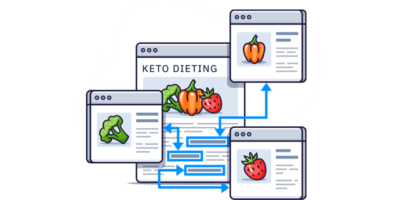Last month, I bought a laser cutter. If you’ve been in my shoes, you know that one does not simply Google “best laser cutters” and then buy the one most recommended in the ranking articles.
As search marketers, that’s often what we think happens. But here’s what actually happened:

The branch of SEO that cares about journeys like this is search experience optimization (SXO). It focuses on making a brand discoverable along all touchpoints in modern search journeys, no matter where they start or what path they take.
Search is becoming more of a ‘choose your own adventure’ experience.
I interviewed some of the industry’s top experts and consolidated their advice into a process for optimizing brand visibility everywhere people search these days. Big thanks to:
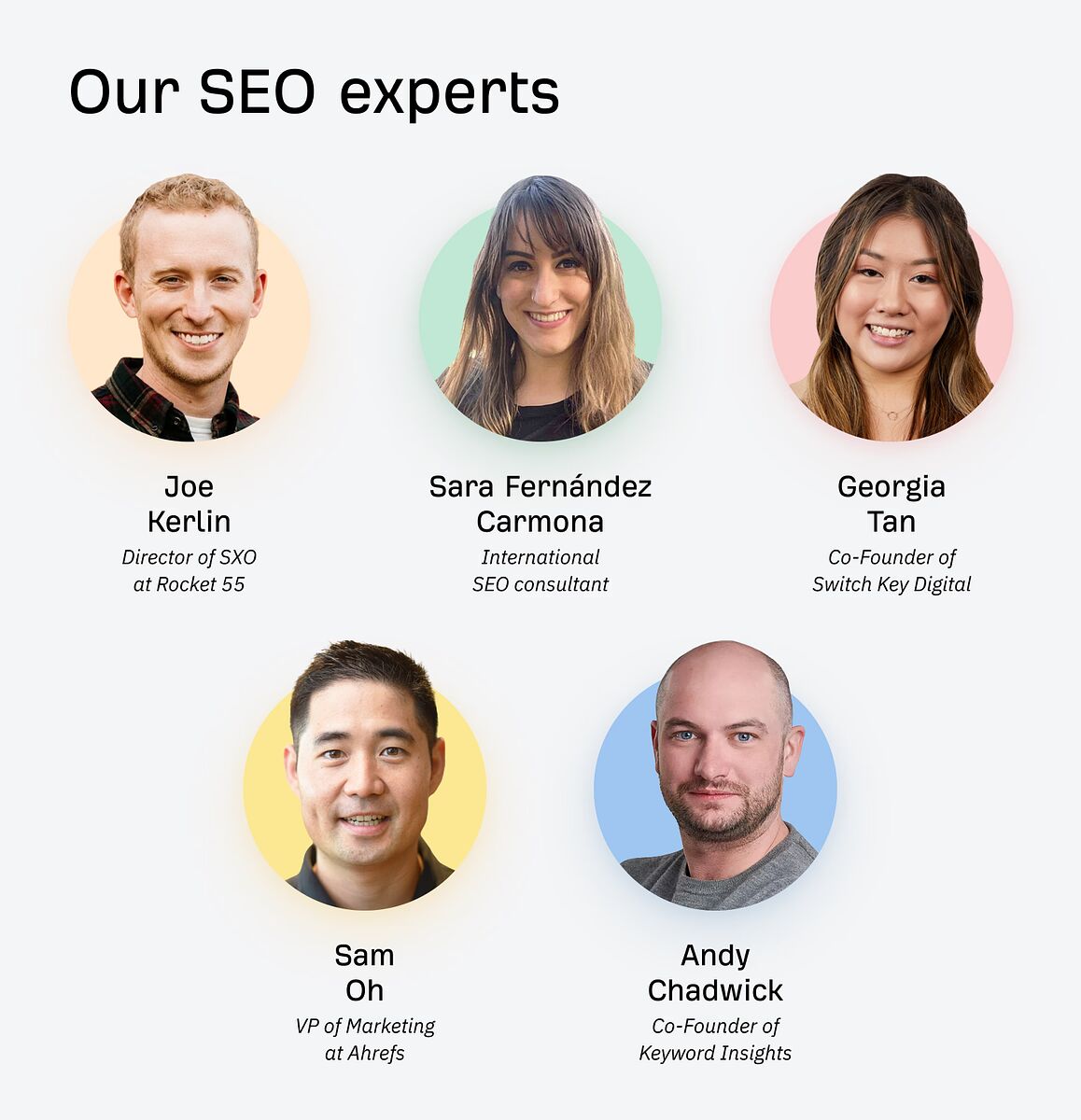
SXO is about optimizing a brand’s presence for non-linear search journeys over multiple platforms, not just Google.
Unlike search engine optimization (SEO), which traditionally focuses on a website’s Google rankings, SXO incorporates user experience elements. It prioritizes a person’s entire experience from initial search through to conversion.
For example, if you sell laser cutters, it’s about helping potential customers through the process of:
- Figuring out what they want to make
- Sourcing the right materials
- Showing them exactly how to make these things
- Recommending products for different budgets or use cases
It’s also about doing the above in forums, on YouTube, and anywhere else they look for information, on and off your website. If you don’t show up where they are searching, you miss many opportunities to connect with potential customers.
The goal of SXO is to create an integrated experience from search to interaction. It’s essential to understand where your audience is searching and to ensure that their experience is optimized across all those touchpoints, reinforcing the notion that every interaction is part of a cohesive, integrated set of experiences.
Let’s now put this into practice. Here’s a step-by-step process for getting started with SXO.
This step starts by understanding that searchers looking for information differ from users who’ve entered your marketing funnel and are interacting with your website.

Typically, a searcher is:
- Unaware of your brand
- On an active hunt for reliable answers or recommendations
- Not interested in your brand unless you provide exactly what they’re looking for
As an audience segment, searchers are best segmented by the patterns in how they think and their motivations for why they’re looking for something.
There are two parts to this: the searcher’s intent and their lens.
Search intent is a concept used in SEO to understand why someone searches for a specific keyword. It focuses on the micro level and is considered on a keyword-by-keyword basis.
For example, someone searching for “buy laser cutter” would have a transactional intent as they’re ready to spend some cash. Someone searching for “laser cutter projects” has an informational intent.
In UX, the concept of a lens applies to the entire journey and is about the macro level. For instance, someone interested in “making cool stuff” may search both of the above keywords (or similar) at some stage.
You need to consider both intent and the searcher’s lens for SXO.
I like to start by understanding the micro intents using Ahrefs’ Keywords Explorer and checking out the Matching terms report.
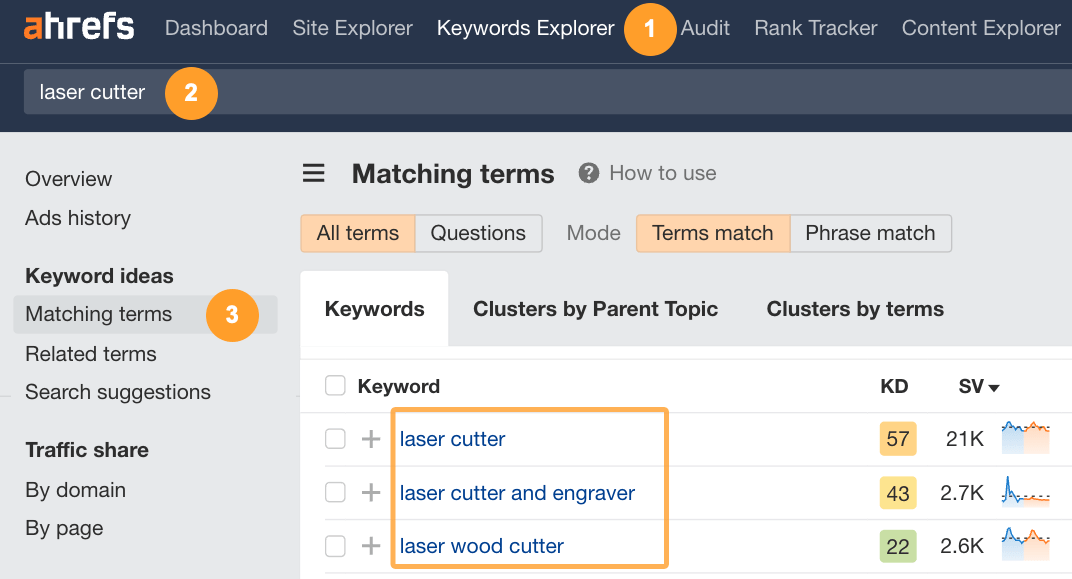
Then, I look at the ranking pages for a handful of terms relevant to my audience by clicking the SERP dropdown and checking out the Identify intents feature:

Doing this gives you a breakdown of the common reasons why people are looking for your product or service, like:
- 45% want to compare laser cutters
- 28% want to buy a laser cutter
- 18% want to learn about laser cutters
- 8% want to watch reviews or tutorials
- 2% want to view images of laser cutters
These are the micro-intents. The more keywords you look at, the more you’ll get a feel for the macro-level and why these people are searching to begin with. For example, a lot of people who look for laser cutters want to make cool stuff.
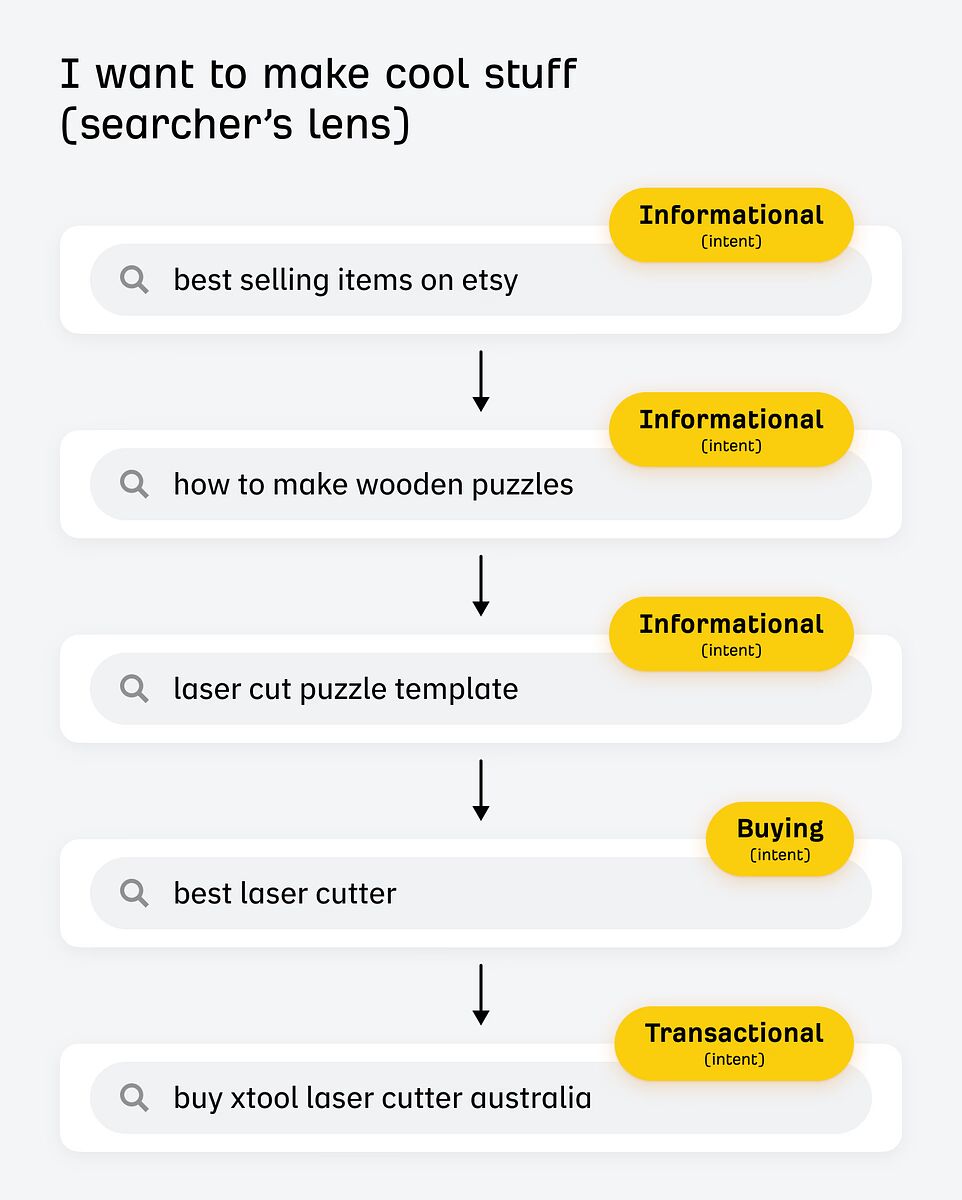
Take the time to research your audience and understand common patterns in how they think and what they’re seeking from their search experiences.
When you understand that the main drive is “to make cool stuff”, or whatever the equivalent lens is for your industry, you open up a broader understanding of the search journeys people go through before they’re ready to buy.
For instance, before I bought the laser cutter, I searched 195 different keywords on Google and countless more on platforms like Amazon, Etsy, and even specific e-commerce stores. Of these, only twenty included the word “laser”.
In order to know what laser cutter is best for the stuff I want to make, I first needed to know:
- What am I interested in making?
- What materials do I need to make these things?
- Can I get those materials easily or do I need to find an alternative option?
- What’s the exact step-by-step process for making these things?
- What type of laser fits my budget and covers all my needs?
Chances are, people in your industry are also asking a tonne of questions:
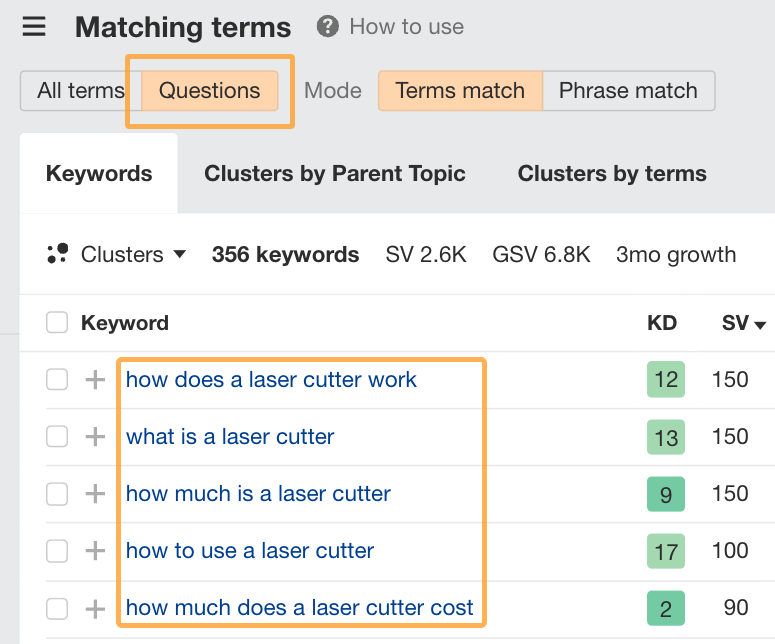
I like to look at the Clusters by terms to see what themes and general patterns show up. Then, I do keyword research on each cluster separately.
For instance, it’s common for people to search for material-related phrases when shopping for laser cutters, like acrylic, wood, metal and vinyl.
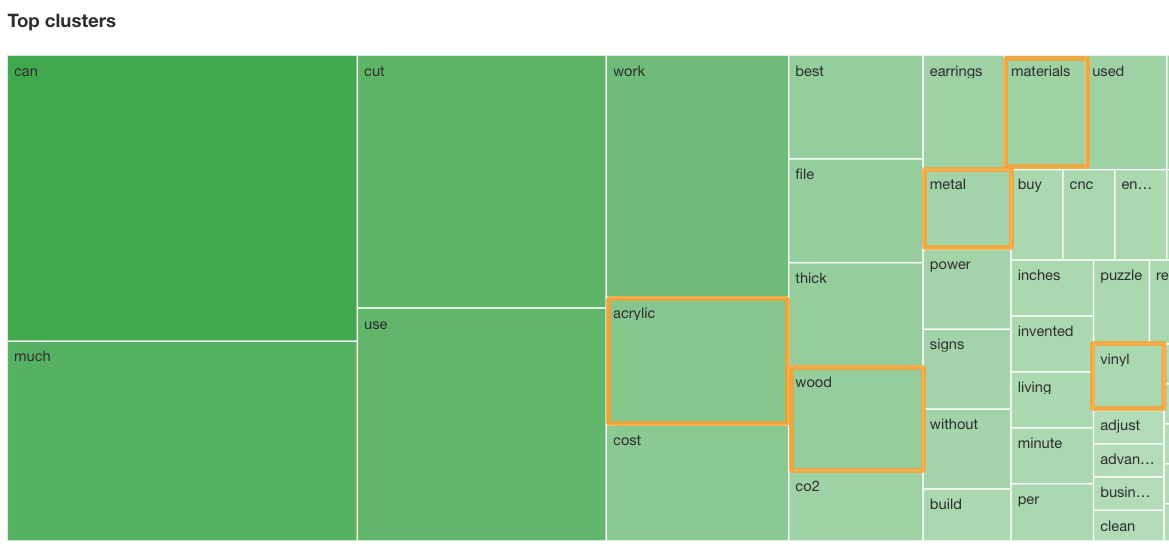
They also search for things they can make, like earrings and puzzles. In this example, I’d then do keyword research for anything with a DIY intent that overlaps with the things people search for related to lasers.
That could be anything from “how to make a wooden puzzle” to “buy bulk basswood sheets”.
While searching for these keywords, I also like to check out the Traffic share by domain report to get a feel for what websites and platforms searchers may visit. For instance, I checked all of the outlined sites before I bought my laser cutter, and your audience is likely to follow a similar pattern:

Let’s take a closer look at this.
Search behavior is changing. Google is not always the platform of choice for modern searchers, with more people satisfying their curiosity elsewhere.
For instance, Gartner predicted a 25% drop in upcoming search engine usage due to AI chatbots.
These days, the five types of platforms where most searches tend to happen include:
- Search engines
- Social media
- Marketplaces
- Forum + discussion threads
- Generative AI + chatbots
For instance, in my journey to buy a laser cutter, 6% of my clicks went to Google, 38% to marketplaces and 57% to various retailers. However, in terms of time, I spent 41% on social media (especially YouTube and TikTok) and forums.
Here’s how to find the right platforms to target for your SXO strategy in each of these categories.
Search engines
Today, at the time of writing this, over 10 trillion searches have been made on Google (and counting)!

If Gartner is correct and we do see a 25% drop in search engine usage, that will still be a whopping 7.5 trillion daily searches happening on Google alone. Not to mention other search engines like Yep, Bing, Baidu, and Naver.
Search marketing is a formidable channel and won’t just disappear overnight.
To find how popular search engines are in your industry, check out the Overview tab in Keywords Explorer.
For example, for the keyword “halloween costumes” we get the following stats:

Pay attention to the estimated monthly search volume (locally and globally), traffic potential, and forecasted search volume. The higher these numbers, the greater the potential to gather traffic from search engines in your industry.
The forecasted volume graph can also indicate general trends over time so you can spot if interest in your industry is trending up or down over time.
Social media
After Google, the second most popular search engine is YouTube, a social media platform.
Other social platforms that people search for information on include FaceBook, LinkedIn, Twitter/X, TikTok, Instagram, and Pinterest.
Social media platforms are great at providing alternative content formats. For instance, people who prefer short-form video content are more likely to search on a social platform like YouTube or TikTok than Google.
I like to use SparkToro to get a sense of the most popular social platforms for a topic.
For instance, after YouTube and Facebook, people interested in content marketing are more likely to use LinkedIn.

However, people interested in dancing prefer to use Instagram, Reddit, and Twitter before LinkedIn.

It can take the guesswork out of which social platforms to prioritize in your industry.
Marketplaces
Marketplaces are a common place where people search for products. For example, instead of turning to Google, many people go straight to Amazon or Etsy to find a product they’re looking for.
The specific marketplaces that are relevant in your industry may be different and you can use Ahrefs to uncover them.
For example, let’s look at the keyword “amigurumi” (which is a type of crochet craft). In Keywords Explorer, you can check out the traffic share by domain report to see the top websites ranking.
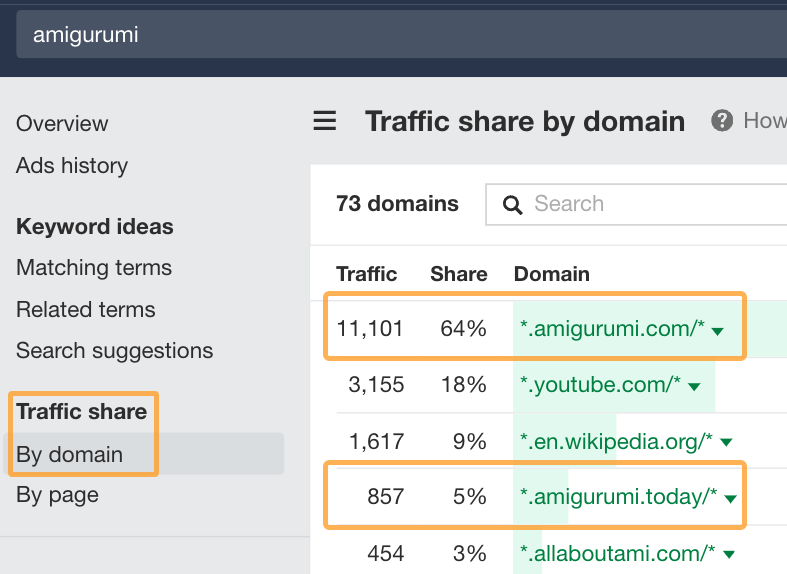
In this example, the top two industry-specific sites (amigurumi.com and amigurumi.today) are marketplaces offering crochet patterns from various artists.
This is a simple example of industry-specific marketplaces that amigurumi artists can feature their designs on. It’s likely your industry may also have niche marketplaces to feature your brand in.
Forums + discussion threads
Reddit and Quora are two of the most common platforms offering user-generated answers to questions. They’re great sources of first-hand experiences and crowdsourced knowledge about a topic.
Many times, people want to hear stories, recommendations, and experiences from other people instead of reading blog posts or consuming social media content.
There are two ways you can use Keywords Explorer to quickly find specific conversations happening in forums about your topic.
The first is to use the SERP features filter and to only include “Discussions and Forums”:

By doing this, you’ll get a list of keywords related to your industry where people are interested in user-generated content.
You can also check out the ranking pages for specific keywords in this list to see what threads or conversations are ranking. It’s ideal for you to join these conversations and reach more people interested in the topic.
Here’s an example of relevant discussions on the topic “aquaponics vs hydroponics”:

The second method is to check out the Traffic share by page report and to look for specific subreddits or forum threads. For example, Reddit gets 3% of the traffic share for “ChatGPT” related searches:
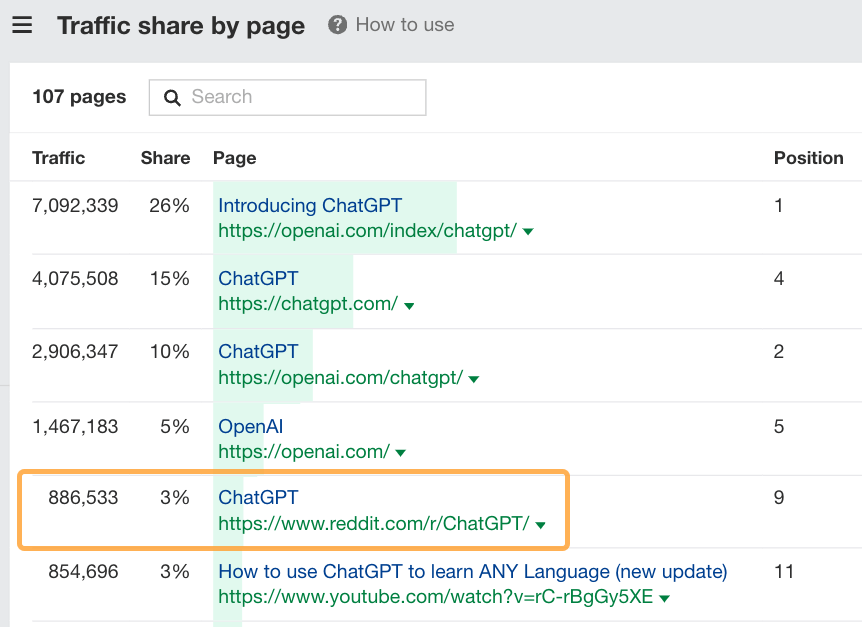
Generative AI + chatbots
Generative AI is the new kid on the block, but all signs point to it sticking around.
People are using this technology to look for all sorts of things and it’s likely to increase once SearchGPT is made available to the public. That’s why most of the big tech giants have adopted AI technology in one way or another:
- Microsoft has heavily invested in ChatGPT
- Google has created Gemini
- Apple’s Siri leverages Gen AI
- As does Meta AI and LinkedIn AI
You get the idea.
As far as search experiences go, however, here’s what fascinates me the most. If you do a good job showing up on all the platforms mentioned above, chances are high you’ll also show up within AI-powered tools and chatbots.
Think about what data they’re trained on.
For instance, Bing’s search index powers ChatGPT. Google has partnered with Reddit to train its AI models.
So, to show up in the responses of AI-powered answer engines, you need to first show up in the platforms they use to fill their knowledge bases.
I also really like Wil Reynold’s take on this. He’s already getting leads through ChatGPT and is tracking differences in brand visibility between search engines and LLMs. Check it out:
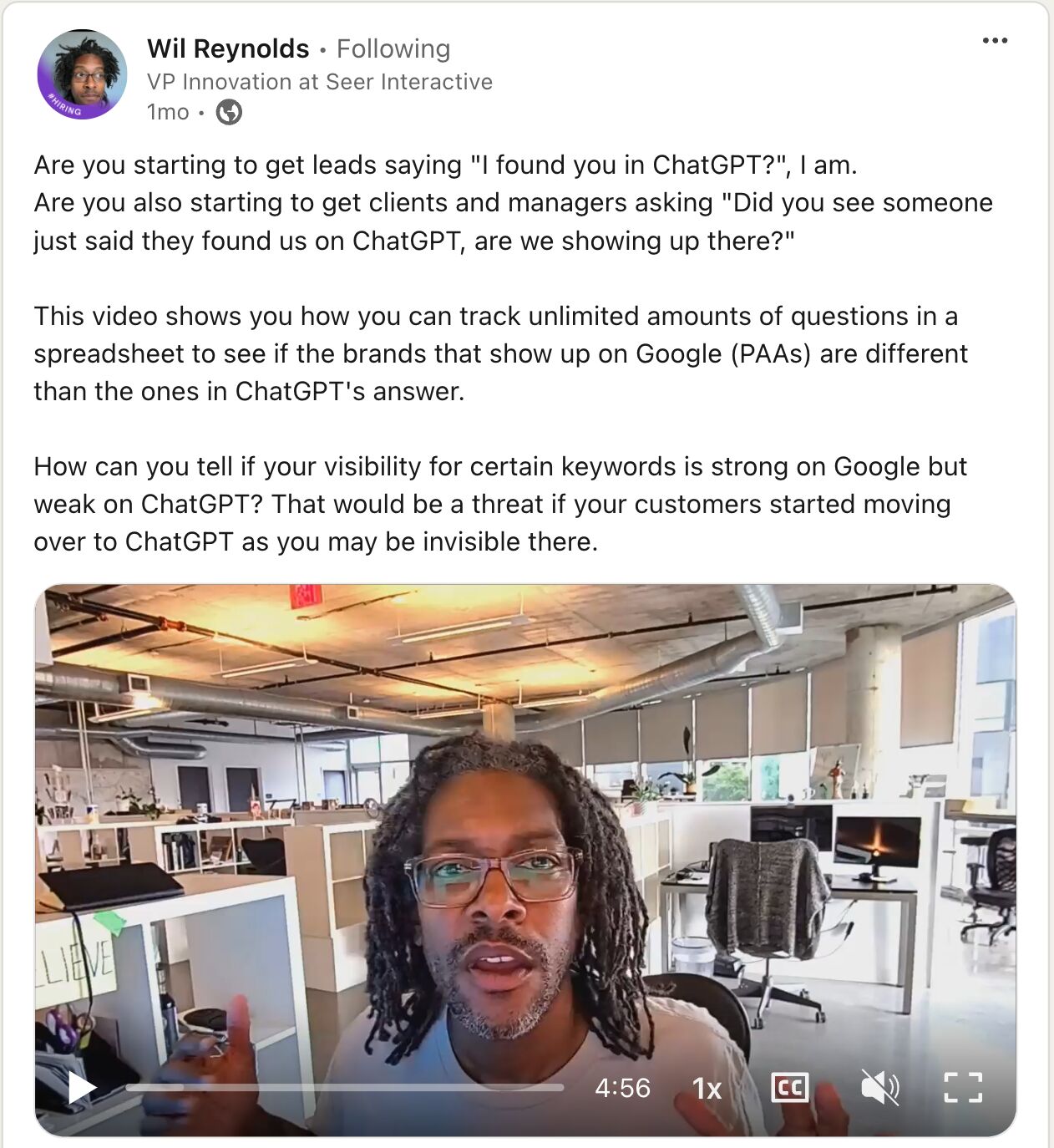
Once you have an idea of who your audience is and what platforms they search on, it’s time to map their search journeys. This will help you identify content gaps you can fill and untapped opportunities to increase your brand’s visibility.
To do this, we’re going to borrow the UX concept of journey mapping. We’ll look at the pre-funnel journey and what platforms searchers visit to get the information they’re seeking.
The point isn’t to map the exact steps in a linear format because that’s nearly impossible these days.
Search journeys are too complex now to really give attribution accurately. Attribution gets even more difficult for things like “the start of a search journey.” There’s too much info out there. Things aren’t linear. We’re bombarded with ads and social content without realizing it. In experiences like this, no specific channel can be attributed to anything other than the fact it was part of the person’s journey.
Instead, it’s about understanding how different lenses impact the steps people take and decisions they make while searching.
Let’s put it into action with this example scenario:
Her search lens is all about the last-minute nature of her purchase.
Now, pretend you’re Jane and look for last-minute costumes on each relevant platform listed in the step above. For each platform, assess how easy it is for Jane to find what she wants. Pay attention to the possible emotional experiences that will influence her next steps.
Then, map the experience for each platform. I really love Georgia Tan’s template for this; I have now added emojis as a scoring mechanism for my own journey maps too!
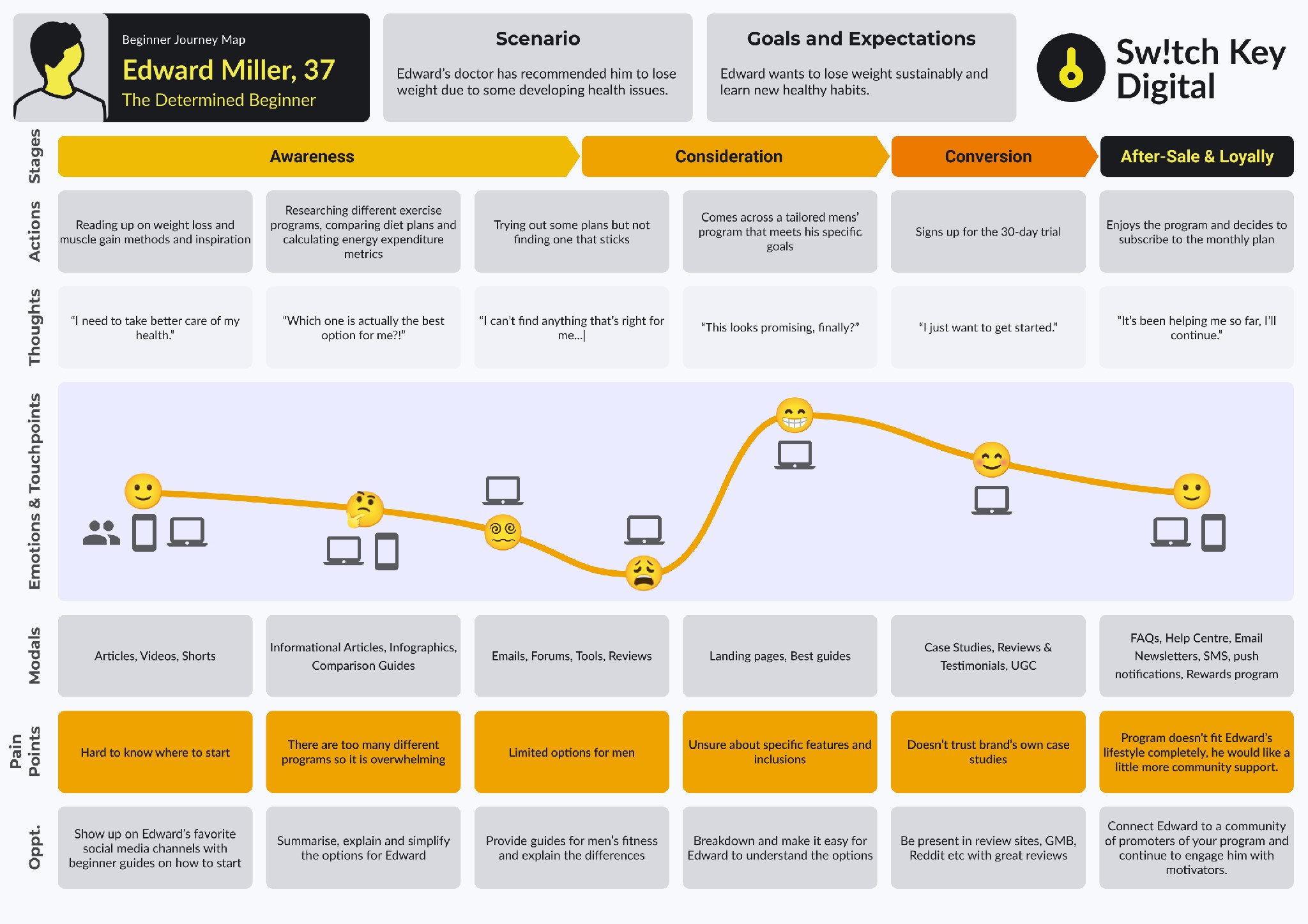
For instance, say Jane starts by searching for “last minute halloween costumes” on Google.
Using Ahrefs’ Identify Intents feature, we can see that 51% of the search results are about DIY costumes and 27% are lists with ideas (also for DIY).
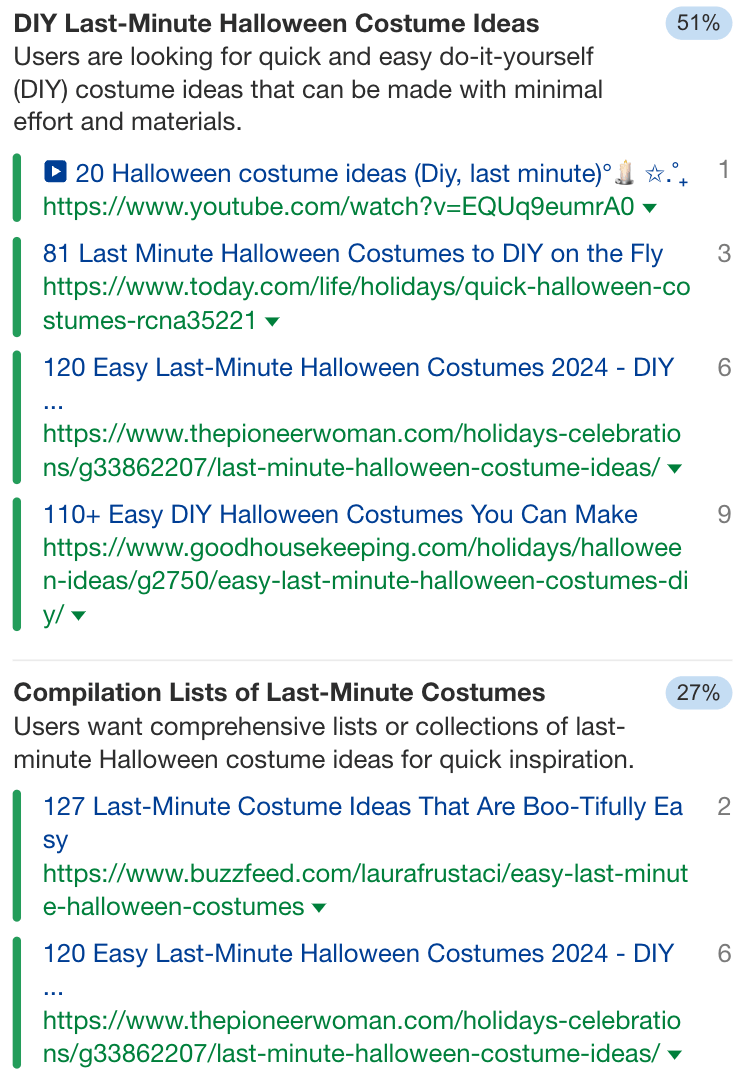
If Jane’s intention is to buy some costumes, she may not feel like Google’s results are particularly helpful. She may also be feeling some slight frustration here because the results are not what she expected.
So, on our journey map, we might score this experience as a 2/5 in terms of how well it satisfied Jane’s expectations. Then, consider her next step in the journey and repeat the process until you reach the end.
The beauty of considering a searcher’s emotional and psychological state at each step is that you gain insights into what problems your content can help solve.
I like to plot each platform on a matrix based on how likely it is that people search on it and how satisfying the results are to a searcher.

It helps with knowing which platforms to prioritize in your content plan. It also helps you spot untapped opportunities to increase brand visibility. The platforms with the lowest satisfaction usually have a content gap you might be able to fill quickly and easily.
| Quadrant | Pattern | Potential | Action |
|---|---|---|---|
| Q 1 | High search potential, Low satisfaction | Offers the most potential for you to become the go-to source of information fairly quickly and easily. | Double down on your efforts |
| Q 2 | High search potential, High satisfaction | It will take some time to earn consistent visibility and to build an audience due to competition levels. | Worth investing for the long run. |
| Q 3 | Low search potential, High satisfaction | It’s great to have a presence here, but dial back how frequently you post or how much effort you invest. | Run a test to gauge audience responses. |
| Q 4 | Low search potential, Low satisfaction | The only time it’s worth investing in these platforms is if your content can shift them into either Q1 or Q3. | Run a test to gauge movement toward Q1 or Q3. |
The type of content you’ll need to create will depend on which platforms are in the first and second quadrants of your matrix. Generally, you’ll want to consider a content strategy that covers a variety of:
- Content types: like videos, social posts, blog posts, or website landing pages.
- Content formats: like how-to posts, listicles, answers to questions, or product reviews.
- Content angles: like opinion pieces or sharing the latest data.
Where possible, it’s worth covering the same topic across multiple content types and formats. For example, let’s take the topic of link building strategies and tactics.
We’ve published a handful of long-form blog posts covering different angles, like:
- 9 Easy Local Link Building Tactics
- 9 Easy Link Building Strategies (That Anyone Can Use)
- 4 Tactics for High-Quality Backlinks That Move the Needle
Sam has also created a video but has selected an angle that’s a better fit for audiences on YouTube: Link Building Tactics No One is Talking About
And, we’ve also published many social posts about it, adapting the content to fit the native audience of each platform, like this short and sweet LinkedIn post:
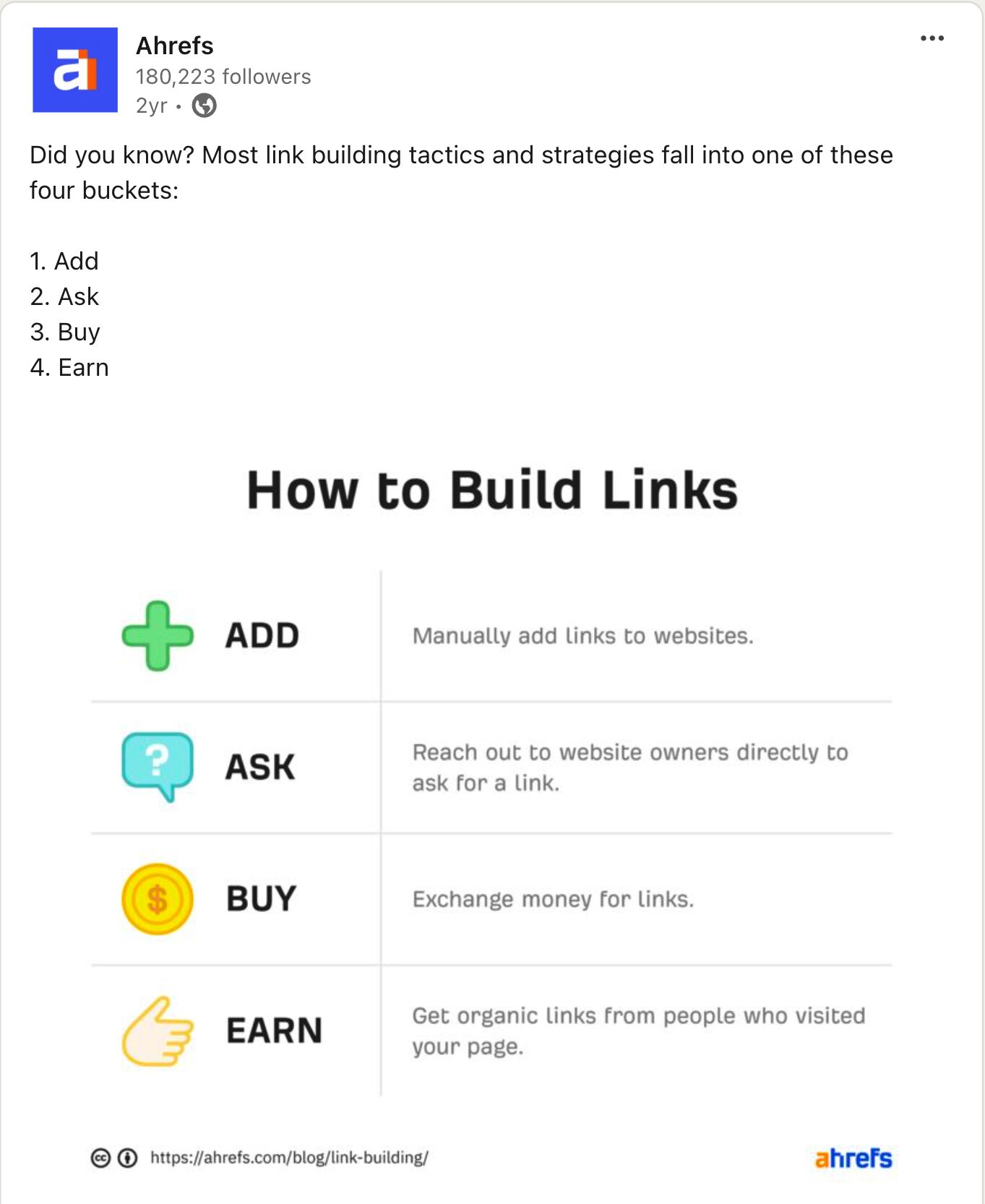
I like to start with a long form piece of content and then distribute that in multiple ways. For me, it’s easier to write a post, then turn that into images, videos, audio clips and so on. You can also start with a video instead if you find that easier than writing.
The ultimate goal of SXO is to provide a seamless experience from search through to conversion. In most cases, your website will be the central hub where people eventually buy what you’re selling, so I recommend doubling down on improving its user experience and conversion potential.
Optimizing things like your core web vitals and website speed offers remarkable gains for SEO and UX alike. You can check these using the performance report in Ahrefs’ Site Audit:
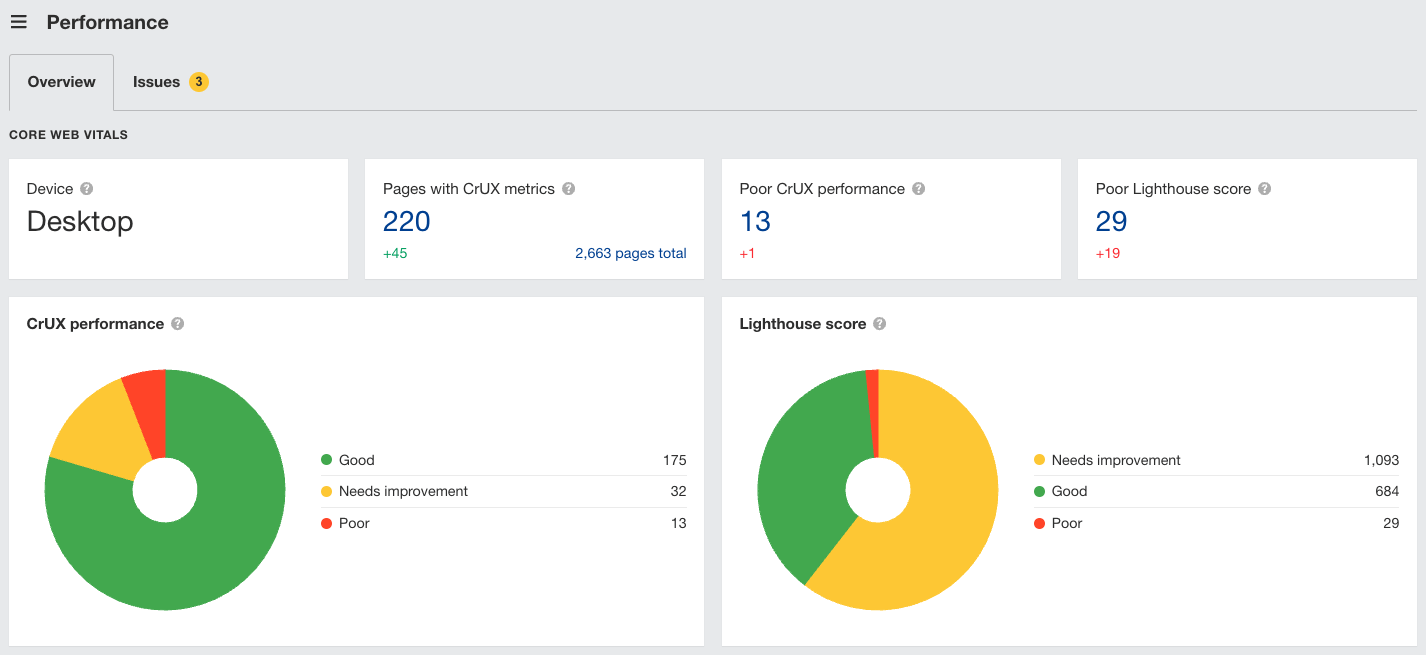
However, you need to go beyond only looking at technical things.
You need to factor in the effectiveness of your designs and content messaging on each page. Do they provide a seamless experience no matter what platform visitors have found your website through?
There’s a whole lot I can say about improving your site’s UX and optimizing for conversions. Nothing beats actually getting feedback from users though. So try out something like usertesting.com to get unbiased feedback on what’s working and what’s not, then improve in iterations.
Where possible, it’s also worth optimizing each platform in your SXO strategy to get native conversions so people don’t have to leave or interrupt their journey by going off-platform.
For instance, if you run an ecommerce store, you can add your products to:
- Popular marketplaces in your industry
- Google’s Merchant Centre
- Social platforms with purchase functionality, like Facebook and Instagram
If the platforms you’re optimizing for your SXO strategy don’t offer native shop functionality, you can instead leverage paid ads to help get searchers deeper into your funnel and closer to converting before they land on your site.
It’s becoming much harder to track how people discover your brand in a zero-click world. But there are a few ways you can still measure success with your SXO efforts.
The first is to run through the journey mapping process after a while and note any changes in searcher satisfaction as a result of your efforts. For example, if you’ve added content on platforms in the first quadrant (high search potential, low satisfaction) and received many positive comments about it, that’s a sign of success right there.
If you’re after a more automated solution, the challenge is that there’s no single tool that accurately tracks your brand visibility all over the web. However, you can use a dashboarding platform like Whatagraph:
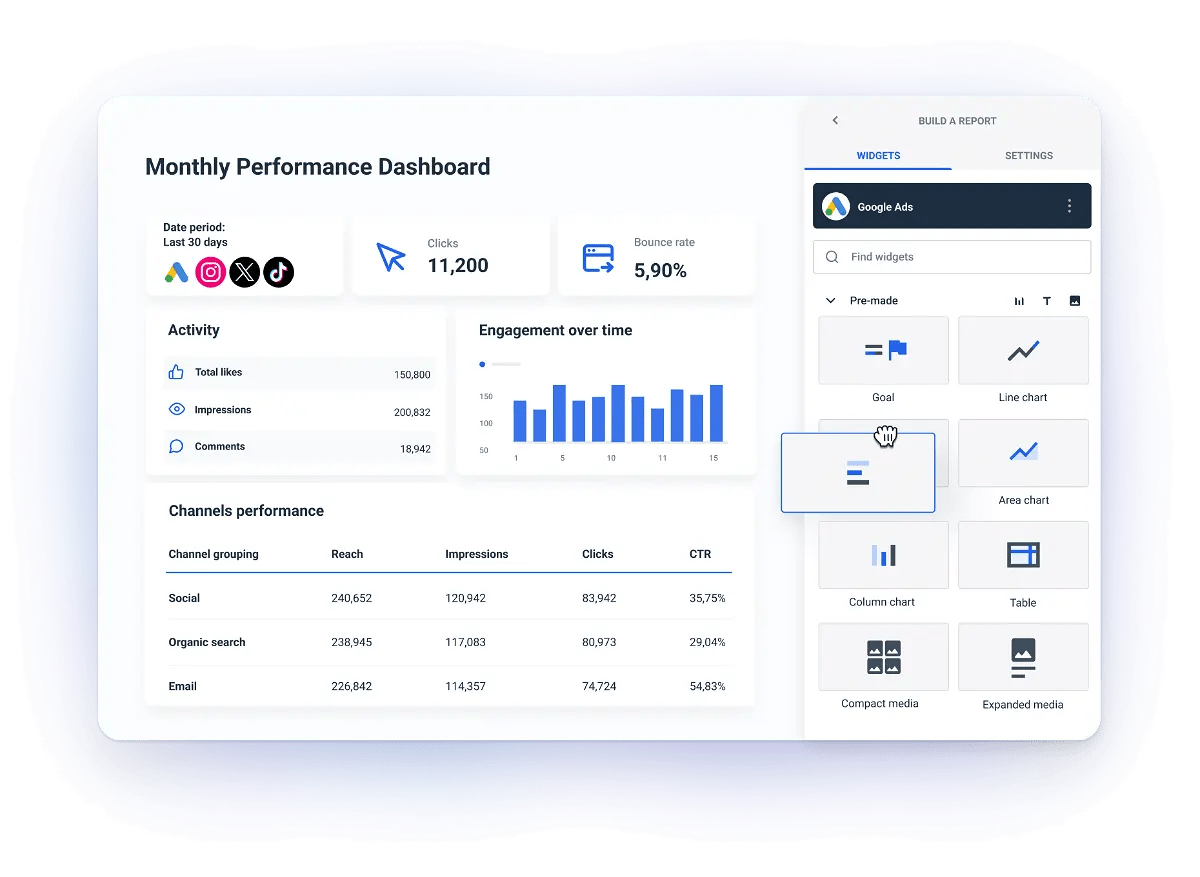
It integrates with all the popular social media platforms, search engines, and website analytics tools to get performance data across most of the platforms mentioned in this post.
I really liked Georgia’s take on this since it combines the metrics that matter for SEO, user experience, and conversion optimization. It is very similar to the metrics I measure for my clients too, for example:
| Metric | What it measures | Where to track |
|---|---|---|
| Organic traffic | The number of organic website visitors from search engines. | Website analytics |
| Organic traffic value | The $ value of your traffic from organic search channels. | Ahrefs |
| Click-through rate (CTR) | The percentage of users who click on a link, usually from a search engine or social platform to your website. | Google Search Console |
| Referral traffic | The number of visits from other websites including social media platforms, marketplaces or other sites. | Website analytics |
| Bounce rate | The percentage of people who leave your website after visiting only one page. | Website analytics |
| Dwell time | The average length of time visitors stay on a page on your website. | Website analytics |
| Pages per session | How many pages users visit on your website in an average session. | Website analytics |
| Heatmapping | A visual breakdown of where user attention flows on a webpage. | Crazy Egg (or similar) |
| On-page interactions | Measuring scrolls, clicks and other interactions that occur on a webpage. | Crazy Egg (or similar) |
| Goal completions | How many actions users took on your website that you wanted them to take, like phone calls, booked demos or product sales. | Website analytics |
| Conversion rate | The percentage of visitors who complete goals or convert. | Website analytics |
There are three main areas you can improve based on what you can measure:
- Traffic acquisition: Increase brand touchpoints by getting more traffic and impressions on your content.
- User experience: Provide a more satisfactory user experience from search through to conversion on any platform relevant to your business.
- Conversions: Increase conversion potential by using more native features on the platforms where you’re seeing visibility growth.
Key takeaways
Search experience optimization is about optimizing the entire journey from search to conversion no matter what platforms people visit along the way.
Ultimately, it’s about making your brand more visible by offering the solution people are looking for, on the right platform, at the right time.
The future of search isn’t just about ranking high, it’s about creating an experience that search engines and users trust. SXO is the key to future-proofing your brand’s presence, ensuring it remains discoverable, engaging and trustworthy as AI continues to reshape how we search for information.
If you’ve got any questions or are nerdy enough to check out your own search journeys, share them with me on LinkedIn!





